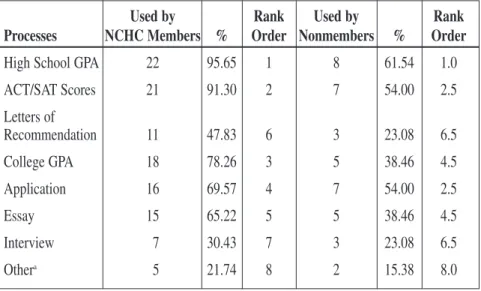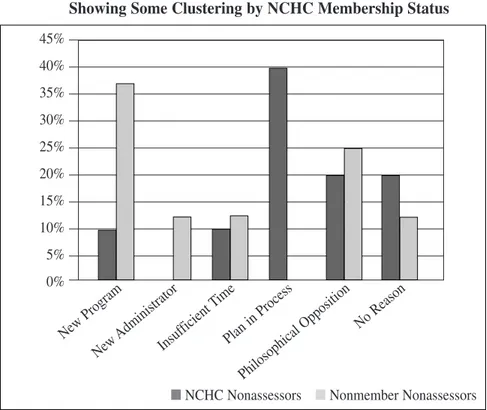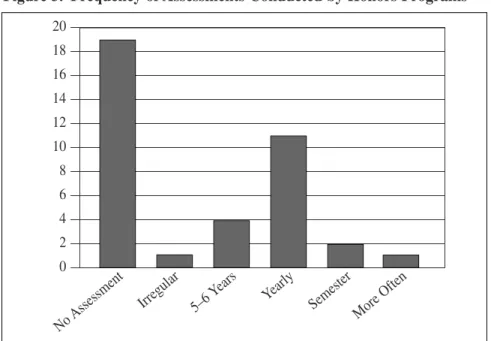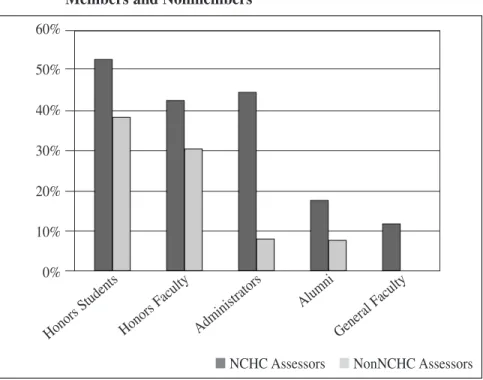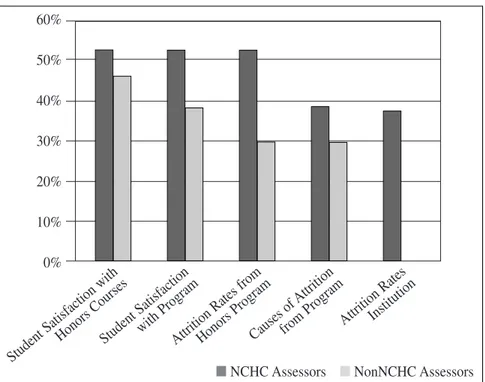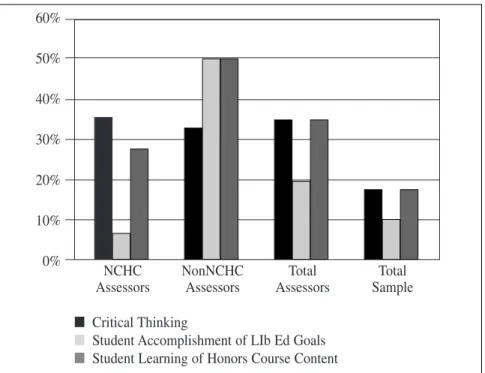DigitalCommons@University of Nebraska - Lincoln
DigitalCommons@University of Nebraska - Lincoln
Journal of the National Collegiate HonorsCouncil --Online Archive National Collegiate Honors Council
2011
National Survey of College and University Honors Programs
National Survey of College and University Honors Programs
Assessment Protocols
Assessment Protocols
Marsha B. DriscollBemidji State University, mdriscoll@bemidjistate.edu
Follow this and additional works at: https://digitalcommons.unl.edu/nchcjournal
Driscoll, Marsha B., "National Survey of College and University Honors Programs Assessment Protocols" (2011). Journal of the National Collegiate Honors Council --Online Archive. 303.
https://digitalcommons.unl.edu/nchcjournal/303
This Article is brought to you for free and open access by the National Collegiate Honors Council at
DigitalCommons@University of Nebraska - Lincoln. It has been accepted for inclusion in Journal of the National Collegiate Honors Council --Online Archive by an authorized administrator of DigitalCommons@University of Nebraska - Lincoln.
National Survey of College and
University Honors Programs
Assessment Protocols
M
ARSHAB. D
RISCOLLBEMIDJISTATEUNIVERSITY
INTRODUCTION
E
ducators concerned with the development and maintenance of collegiate honors programs throughout the United States face considerable hurdles in these times of decreased funding, concerns about charges of elitism, and calls for accountability (Campbell 95). In 1990, the National Collegiate Honors Council (NCHC) published a monograph that identified a minimum of five concerns that should be periodically and systematically evaluated within a program: causes of attrition, liberal education goals of the curricu-lum, participation in cultural and community activities, administrative struc-ture and budget, and advising responsibilities (Reihman, Varhus, & Whipple). Although the NCHC, as well as accrediting bodies, strongly supports the assessment of honors programs, Greg Lanier reports little consistency in the process or the findings of such assessments (84).In spite of a growing body of literature supporting the benefits of honors programs (Achterberg; Cosgrove; Hartleroad; Park & Maisto; Ross & Roman; Seifert, Pascarella, Colangelo, & Assouline; Shushok), some mem-bers of the national community of honors educators remain resistant to the concept of assessing their programs. Lanier cites the spring/summer 2006 volume of the Journal of the National Collegiate Honors Council (JNCHC) that included nine essays in its “Forum on Outcomes Assessment, Accountability, and Honors”; he writes that two thirds of them focused on the problem and dangers in program assessment. A common theme in several of the essays opposing assessment was that the unique and qualitative nature of the stated outcomes of honors programs makes assessment difficult or unhelpful (Digby; Freyman; Strong).
My question was whether honors educators in 2009 had regular methods of evaluating honors or were resisting the national movement to require empirical evidence of the success of their programs. This paper reports the results of a national survey of honors program assessment protocols among
both NCHC members and nonmembers to determine whether honors pro-grams are being assessed and, if so, how they are being assessed.
METHOD
P
ARTICIPANTSHonors programs were identified through two methods. A current (2009) listing of members of the National Collegiate Honors Council was obtained from the NCHC website <http://www.nchchonors.org/memberinstitu tion.shtml>. Member institutions were numbered, and a hundred participants were randomly selected.
Nonmembers of NCHC were identified through a member list of all Association of American Colleges and Universities (AAC&U) institutions available through the AAC&U website at <http://www.aacu.org/member ship/list.cfm>. The NCHC member list contains over 800 institutions and the AAC&U list contains over 1,200; however, the overlap is considerable. Those AAC&U members which were also members of NCHC were elimi-nated, as were those listed that were not colleges, community colleges, or uni-versities. The resulting population of non-NCHC member institutions was just over 600. One hundred participants were randomly selected from the AAC&U list, with ineligible names eliminated. Additional random selections occurred until the non-NCHC participants also numbered 100. Of this sam-ple, 27 were eventually eliminated because they did not have an honors pro-gram. The remaining non-NCHC sample of 73 reflects about 11% of the total AAC&U institutions that are not members of NCHC while the NCHC sam-ple of 100 reflects approximately 12% of the NCHC member institutions.
The final two groups consisted of 100 members of NCHC and 73 non-members of NCHC. Completed responses were returned by 24 NCHC mem-bers (24%) and 14 nonmemmem-bers (19%) for a total response rate of 38 (22%).
M
ATERIALSMaterials consisted of a three-page questionnaire, The National Survey of
College and University Honors Programs Assessment Protocols, which was
developed by the primary researcher (see Appendix A). The questionnaire was developed based on five concerns that a 1990 NCHC monograph identi-fied as important for periodic assessment and general liberal education out-comes, and it included both objective and open-ended questions.
P
ROCEDUREHonors directors/coordinators/administrators were identified through the sampling procedure described above. Once participants were identified, they
were notified by email that the survey would be mailed to them. The email contained the purpose and methodology of the study (see Appendix B). The surveys were sent via U.S. mail to the office of the honors administrator along with a stamped, addressed envelope. Different colored paper was used for NCHC members and nonmembers in order to differentiate membership with-out violating confidentiality. Instructions for completing the survey included the statement that consent was assumed with the completion of the survey. Participants were given the author’s email and telephone number for contact if they had questions regarding the use of the survey data. The researcher received ten emailed questions from recipients of the questionnaires. Half of the email responses consisted of clarifying questions regarding the use of the data and half included statements of agreement to participate. Two respon-dents requested that the results be sent directly to them.
A general follow-up email was sent to all participants to improve the return rate of surveys (see Appendix C). Because the surveys were anony-mous, the researcher does not have data regarding characteristics of who responded and who did not.
RESULTS
D
ESCRIPTION OFR
ESPONDERS ANDP
ROGRAMSA majority of the respondents described themselves as directors (n = 31), and the rest were coordinators (n = 2), administrators (n = 3), faculty (n = 6), and chair of the honors committee (1). Five respondents held dual positions. The programs studied varied in size from a minimum number of 15 stu-dents to a maximum of 1150. They also varied in selectivity, with the per-centage of the school population that participated in honors ranging from 0.4% to 13%. Tables 1 and 2 show no significant difference in size between the NCHC member and nonmember programs, nor do they show a significant difference in their selectivity. Both NCHC member and nonmember pro-grams primarily rely on high school grade point average (GPA) and testing (ACT or SAT) for admissions, with college GPA and formal applications also commonly used. These descriptors suggest that NCHC member and non-member programs are relatively similar.
As Table 3 demonstrates, the percentages of schools using each criterion are higher for the NCHC members than for the nonmembers. In fact, NCHC member schools appear to be more likely than nonmembers to gather data on students who are applying to their program prior to making a decision about admission. An independent samples t-test showed that NCHC members used more sources of information about students in making their selections for admissions to their programs (M=4.96) compared to the number of sources used by nonmembers (M = 3.29); t(36) = 2.96, p< .01.
Membership Standard Status Minimum Maximum Mean Deviation
NCHC (n=20) 0.4% 12% 4.8% .037 NonNCHC (n=13) 0.9% 15% 7.4% .046 Total (N=33) 0.4% 15% 5.8% .042
Table 2. Selectivity of Surveyed Honors Programs: Percent of Student Body in Honors
Note. No significant differences between NCHC members and nonNCHC members
Used by Rank Used by Rank Processes NCHC Members % Order Nonmembers % Order
High School GPA 22 95.65 1 8 61.54 1.0 ACT/SAT Scores 21 91.30 2 7 54.00 2.5 Letters of Recommendation 11 47.83 6 3 23.08 6.5 College GPA 18 78.26 3 5 38.46 4.5 Application 16 69.57 4 7 54.00 2.5 Essay 15 65.22 5 5 38.46 4.5 Interview 7 30.43 7 3 23.08 6.5 Othera 5 21.74 8 2 15.38 8.0 Table 3. Honors Student Selection Methods of Surveyed Programs
Note. Respondents were requested to identify all processes used.
aSpecific responses included other academic work, writing samples, and high school class rank
Membership Standard Status Minimum Maximum Mean Deviation
NCHC (n =24) 20 1150 345 379 Non-NCHC (n =14) 15 600 154 165 Total (N=38) 15 1150 264 327
Table 1. Size of Surveyed Honors Programs
This preference for more data on prospective students may reflect the fact that NCHC member programs may be more likely to compensate their honors directors by allocating more of their time to honors. An independent samples t-test indicated that NCHC member respondents reported devoting a significantly greater percentage of full-time employment to honors (M = 54.70) than nonmembers (M = 27.93); t(35) = 2.46, p<.05.
D
ESCRIPTION OFA
SSESSMENTP
ROTOCOLSA total of twenty respondents reported some assessment of the honors program. Most honors program assessments are the responsibility of the pro-gram director/coordinator (n=18) although some rely on honors faculty and committees (n = 5) and a few on administrators such as deans or provosts (n = 3). Several programs are assessed by more than one agent.
In answer to the question “Do you conduct any assessment of your hon-ors program?” 61% (n=14) of NCHC members responded “yes” and 50% (n=6) of nonmembers reported yes. A chi-square comparison showed no sig-nificant difference in these response rates. Combining the responses showed that a total of 57% responded affirmatively that they conduct some assess-ment of the honors program. Thus nearly 43% of participants report that there is no assessment of their honors program.
Participants were asked a follow-up question to explain their lack of assessment, and these results show that some possible differentiation between
Figure 1. Percentages of NCHC and NonNCHC Samples Grouped by Allotment of Their FTE to the Honors Program.
■NCHC ■NonNCHC 60% 50% 40% 30% 20% 10% 0% 0% 1–25% 26–50% 51–75% 76–100%
NCHC members and nonmembers. Explanations for no assessment clustered as newness of program, newness of administrator, insufficient time, philo-sophical opposition to assessment, and an assessment plan in process but not in place. One member and one nonmember respondent gave no explanation for their lack of assessment. Despite some possible differences between the member and nonmember explanations for no assessment, the numbers are too small to perform a meaningful inferential analysis.
Of the twenty programs that are doing some assessment, fifteen reported conducting regular assessments. The frequency of assessments of all respon-dents is shown in Figure 3. As the figure suggests, most programs that do assessment conduct it on a yearly basis.
Respondents were asked, “What population do you use to assess your honors program?” NCHC members and nonmembers responded in similar fashion. As shown in Figure 4, honors students are assessed most frequently, with honors faculty a close second. Administrators and alumni were assessed less frequently, and general faculty were the least likely to be questioned about the honors program. One respondent (not shown on the graph) report-ed using honors committee members for assessment purposes.
Figure 2. Reasons Given for Lack of Assessment of Honors Programs Showing Some Clustering by NCHC Membership Status
New Program New Adm inistrator Insuf ficient T ime Plan in Process Philosophical O pposition No Reason
■NCHC Nonassessors ■Nonmember Nonassessors 45% 40% 35% 30% 25% 20% 15% 10% 5% 0%
Methods of Assessment
The methods of assessment range from informal discussion among hon-ors committees to detailed rubrics evaluating honhon-ors theses. Only four respondents reported using a formal, standardized, and normed assessment instrument. Of those “standardized” instruments, two were teacher evalua-tions, one was a campus-wide general education evaluation, and only one was a substantive instrument (an “info-lit. survey devised by an Australian insti-tution”) that was neither named nor clearly described. Although respondents identified these as normed measures, it is possible that the questions are stan-dard without the responses being normed. None of the reported stanstan-dardized instruments was named although the follow-up question was “If yes, which standardized tests do you use?”.
Six additional programs reported using formal, non-standardized instru-ments such as course and teacher evaluations. Two programs used formal rubrics for evaluating student work, and two programs used exit surveys. One program used focus groups of honors students, one relied on the university external review process, and one used institutional effectiveness studies.
Of the programs that conducted some form of assessment, five reported using a comparison group. Four of these described their comparison groups as non-honors students in the institution, and one did not specify the com-parison group. None reported identifying a matched comcom-parison group of honors-eligible, non-honors students.
Figure 3. Frequency of Assessments Conducted by Honors Programs
No A ssessm ent Irregular 5–6 Y ears Yearly Sem ester More Often 20 18 16 14 12 10 8 6 4 2 0
Focus of Assessments
Responders were asked to identify all sources of data used to assess their honors program. The programs that assessed were likely to conduct multiple assessments. Only one program reported using only satisfaction surveys. The average number of types of data sources was 6.2 and ranged from 1 to 12 sources with a mode of 7.
Student Satisfaction
The most common sources of data can be seen in Figure 5. In general, these sources consisted of student satisfaction surveys and attrition rates. For all respondents, the most common data collected were student ratings of sat-isfaction with honors courses (n = 18), and the second most common was student satisfaction with the honors program (n = 17). The third most com-mon information used was the attrition rate from the honors program (n = 16) followed by causes of attrition from the honors program (n = 13). The fifth piece of information most likely to be gathered was attrition from the university (n = 10).
Figure 4. Populations Used for Program Assessment by NCHC Members and Nonmembers
Honors Students Honors Faculty Adm
inistrators Alum ni
General Faculty
■NCHC Assessors ■NonNCHC Assessors 60% 50% 40% 30% 20% 10% 0%
Note. No significant differences were found between NCHC members and nonmembers in
Student Outcomes
Course content, critical thinking, and accomplishment of the liberal edu-cation goals might be interpreted as Student Learning Outcomes (SLOs). These areas were assessed at a moderate level by the programs that did some assessment. However, there was no clear evidence of honors programs gen-erally assessing SLOs. Successful behavioral outcomes such as admission to graduate schools (25%) and job placement (10%) fell fairly low in frequency of assessment.
NCHC-Recommended Assessment
The evidence thus far suggests that some NCHC members are assessing two of the areas recommended by the organization in 1990: reasons for attri-tion from the program and accomplishment of the liberal educaattri-tion goals (Reihman, Varhus, & Whipple). The remaining areas recommended for assessment receive limited support from the entire assessing population: par-ticipation in cultural (15%) and community (30%) activities, administrative structure and budget (40%), and advising satisfaction (15%).
Figure 5. Assessment Data Most Frequently Collected by NCHC Members and Nonmembers
Student Satisfaction w ith Honors C
ourses
Student Satisfaction with ProgramAttrition R ates from Honors ProgramCauses of
Attrition from Program Attrition R ates Institution
■NCHC Assessors ■NonNCHC Assessors 60% 50% 40% 30% 20% 10% 0%
Other Areas Assessed
Additional sources of data supplied by the open-ended “other” question were: the percentage of students who completed lower- and upper-division honors courses; personal statements and portfolios; student writing and study abroad; quality of senior honors theses; research accomplishments, service accomplishments, and conference presentations; and “nitty gritty things like how forms and papers are distributed and turned in.”
A
SSESSMENTR
ESULTSSeventeen participants responded to the question “Briefly describe any findings of your assessments during the past three years.” As one would expect, the findings reflect the nature of the data collected. Only three partic-ipants reported findings about the general satisfaction of students; however, seven others reported learning of specific areas in which students were not completely satisfied with such issues as course offerings, advising, the phys-ical location of honors, and availability of scholarships. Eight programs found high retention rates in the institution although two found fairly low retention in the honors program. Two schools found higher acceptance rates in graduate and professional schools among honors than non-honors students.
Figure 6. Rates of Assessment of Student Learning Outcomes by NCHC Members and Nonmembers
NCHC NonNCHC Total Total
Assessors Assessors Assessors Sample ■ Critical Thinking
■ Student Accomplishment of LIb Ed Goals ■ Student Learning of Honors Course Content 60% 50% 40% 30% 20% 10% 0%
One program found high levels of student participation in study abroad, and one found that honors service volunteers “maintain and expand quantity and quality of service” over time.
In less positive findings, two participants reported a lack of diversity and a need for recruiting underrepresented students. One school found that stu-dents demonstrated “confusion regarding liberal education.” An additional two reported finding academic deficits (writing, math, and general) in their honors students that needed to be addressed.
A total of nineteen responders answered the question “How have you used the assessment results?” and only one replied “not used.” Two respon-ders reported a recent decrease in the effectiveness of honors assessment because their institutions were moving to more quantitative and less forma-tive types of assessments. With the exception of the one “not used” response, all of the responders gave examples of how their assessment results are used; however, three programs reported using assessment for planning without fur-ther defining that activity.
A
SSESSMENTA
PPLICATIONSThe most frequently mentioned general use of honors program assess-ment was to provide a basis for changes internal to the honors program. These changes included curricular changes, admission requirements, and program-matic changes. Seven schools reported using assessment to support the addi-tion or change of offered courses, and three schools used their data to support specific course content changes such as additional critical thinking skills, writing skills, and service requirements. Three schools reported changes in their admission processes either to increase academic credentials (n=2) or to increase diversity (n=1). Four programs reported using their data to make changes that would lead to a more cohesive identity among students in the honors program.
The second most frequent general use of honors assessment was to gain and/or maintain institutional support for the program. Eight of the programs reported using their data specifically for the purpose of increasing their resources, including scholarship funds, faculty assignments, or space. Two additional programs reported that they conduct assessment in order to fulfill an institutional requirement, which might be construed as a method for main-taining institutional support.
CONCLUSIONS
The findings suggest a paucity of adequate assessment of honors pro-grams in community colleges, colleges, and universities throughout the coun-try. The connection of program assessment to specific learning outcomes
remains thin. On the other hand, the directors who are assessing their pro-grams generally appear to be using multiple sources of data and report bene-fits from using the information they gather. Finally, although in 1990 the NCHC specifically encouraged its members to conduct regular assessments of causes of attrition, liberal education goals of the curriculum, participation in cultural and community activities, administrative structure and budget, and advising responsibilities (Reihman, Varhus, & Whipple 3–4), I found no clear indications that membership in NCHC increases the likelihood that a program follows these assessment guidelines.
Based on the findings of this study, a little more than half of honors pro-grams conduct some sort of assessment. Although these data must be inter-preted with caution due to the very small numbers, the general representa-tiveness of the sample—in terms of size, selectivity, and time allotment for honors director—may add some strength to the generalizability of the results. There is no way to determine the extent to which these findings are biased; however, one could make the argument that those sampled who are least con-cerned with assessment are the ones most likely to ignore a research request regarding assessment practices
Most of the assessments reported are not directly connected to learning outcomes, but there is evidence of some outcome assessment. Attrition rates, which reflect the positive outcome of completion of the program and the degree, do provide a gross outcome measure and were used fairly frequently in comparisons of honors students to non-honors students. Course content and critical thinking were reportedly assessed by only 35% of the programs that conduct some assessment (18% of the entire sample), yet one might assume that instructors assess these outcomes in nearly every course as the basis for assigning a grade. The simple application of a rubric for use across courses would supply adequate standardization to begin programmatic assessment of learning outcomes. Other outcome measures, such as acceptance to graduate schools and job placement, also suggest positive results from participation in honors. Such data are extremely easy to collect, and the low rates of collection beg the question of why programs do not do so more frequently.
The widespread assessment of students’ satisfaction with courses and honors programs suggests that data collection alone is not the problem. Student satisfaction surveys require at least some time to administer, score, and enter as data, and their widespread use suggests a willingness of at least half of the honors programs to invest in collecting this information. Unfortunately, student satisfaction is notoriously unreliable in assessing the quality of a program (Schuck, Gordon, & Buchanan; Shevlin, Banyard, & Griffiths; Zabeleta). Fortunately, only one assessing program reported relying on student satisfaction surveys alone.
The combination of student satisfaction with other sources of informa-tion apparently provides enough data that most of these instituinforma-tions that con-duct some assessment report benefitting from it. This study suggests that assessment information is useful in guiding changes and planning within an honors program as well as providing strong arguments for continued and increased support from administrators.
At this time there is no clear evidence that membership in the NCHC increases the likelihood that an honors program will conduct assessment or that the quality of the assessment will be substantially different from those honors programs that are not in the NCHC. The data show a higher percent-age of the director’s FTE devoted to the honors program for NCHC members, but these data do not translate into a greater likelihood that NCHC members conduct assessment nor not that they conduct assessment more frequently. The study revealed no real differences between NCHC members and non-members in the methods of assessment used, the sources of data, and the uses to which assessment data are put.
DISCUSSION
This paper began with a question: Are honors educators resisting the national movement to require empirical evidence of the success of their pro-grams, or are they developing effective methods of evaluating honors? The results of this study suggest that the national community of honors programs does not reflect a consensus that assessment is a valuable tool for insuring high program quality. In spite of the organization’s support for assessment, the results of this survey suggest that we are not taking assessment and eval-uation seriously when it comes to our own programs.
Rather than arguing about the inadequacy of assessment or insisting that honors provides some mystical benefit that cannot be measured, I believe we should be doing research to determine effective and reliable program mea-sures and assisting each other in applying them. I agree with Lanier when he described our current situation: “the issue of creating effective and reliable program assessment measures is far more overarching than the natural acad-emic denunciation of legislative threats to impose standardized testing or to create an educational equivalent to automotive assembly lines” (81). As Cheryl Achtenberg wrote, “We teach our honors students to question; we should not shirk when questions are also asked of us . . . [W]e need to recog-nize that assessment and evaluation are essential in honors education” (38–39).
Until honors programs begin using some form of appropriately standard-ized assessments, we will not be able to address concerns about the value of our programs, especially in comparison with comparable student groups. In
the meantime, others are also working on creating these tools for excellent assessment. An example of exemplary assessment is found in the 2005 study by Klein et al. Their approach to measuring cognitive outcomes produced a complex, open-ended critical thinking assessment tool that can be computer-scored with extraordinarily high reliability. Their assessment is specifically appropriate for measuring student learning outcomes at the program level rather than at the individual student level. Although these assessment tools are not necessarily easily available to all institutions at this time, they demon-strate the type of learning outcome assessment that honors programs could develop collaboratively, making use of the shared values of those educators who are dedicated to providing excellent education for our most gifted students.
ACKNOWLEDGMENTS
This research was supported in part by the Department of Psychology at Bemidji State University. Judy Negard, Administrative Assistant for the Honors Program, assisted in developing the questionnaire, and Collin Sainio, graduate student in psychology, gave formatting assistance. Some of the data were presented at the 45th Annual Conference of the National Collegiate Honors Council in Kansas City, MO, on November 22, 2010.
REFERENCES
Achterberg, C. (2006). Honors assessment and evaluation. Journal of
National Collegiate Honors Council, 7.1, 37–39
Campbell, K.C. (2005). Allocation of resources: Should honors programs take priority? Journal of National Collegiate Honors Council, 6.1, 95–103.
Cosgrove, J. R. (2004). The impact of honors programs on undergraduate academic performance, retention, and graduation. Journal of National
Collegiate Honors Council, 5.2, 46–53.
Hartleroad, G. E. (2005). Comparison of the academic achievementof first-year female honors program and non-honors program engineering stu-dents. Journal of National Collegiate Honors Council, 6.2, 109–120. Klein, S. P., Kuh, G.D., Chun, M. & Hamilton, L. (2005). An approach to
measuring cognitive outcomes across higher education institutions.
Research in Higher Education, 46, 251–276.
Lanier, G. (2008). Towards reliable honors assessment. Journal of the
National Collegiate Honors Council, 9.1, 81–116.
Park, D. C. & Maisto,A.A. (1984). Assessment of the impact of an introduc-tory honors psychology course on students: Initial and delayed effects.
Annual Meeting of the Southeastern Psychological Association (p. 14).
Reihman, J. V., Varhus, S., & Whipple, W.R. (1990). Evaluating Honors
Programs: An Outcomes Approach., NCHC Monograph.
Ross, L. O. & Roman, M. A. (2009). Assessing student learning in commu-nity college honors programs using the CCCSE course feedback form.
Journal National Collegiate Honors Council, 10.2, 73–92.
Schuck, S., Gordon,S., & Buchanan,J. (2008). What are we missing here? Problematising wisdoms on teaching quality and professionalism in higher education. Teaching in Higher Education, 13, 537–547.
Seifert, T. A., Pascarella,E.T., Colangelo, N., & Assouline, S. (2007). The effects of honors program participation on experiences of good practices and learning outcomes. Journal of College Student Development, 48, 57–74.
Shevlin, M.P., Baynard, M.D., & Griffiths, M. (2000). The validity of student evaluation of teaching in higher education: Love me, love my lectures?
Assessment & Evaluation in HigherEducation, 25, 397–405.
Shushok, F. J. (2006). Student outcomes and honors programs: A longitudi-nal study of 172 honors students 2000–2004. Jourlongitudi-nal Natiolongitudi-nal
Collegiate Honors Council, 7.2, 85–96.
Tallent-Runnels, M. K., Shaw, S.M. & Thomas, J. A. (2007). Using charac-teristics of K–12 gifted programs to evaluate honors programs. Journal
National Collegiate Honors Council, 8.1, 61–75.
Zabaleta, F. (2007). The use and misuse of student evaluations of teaching.
Teaching in Higher Education, 12, 55–76.
*******
The author may be contacted at mdriscoll@bemidjistate.edu.
